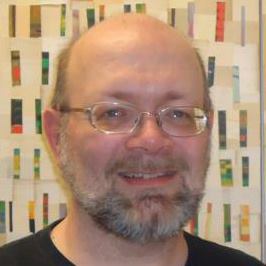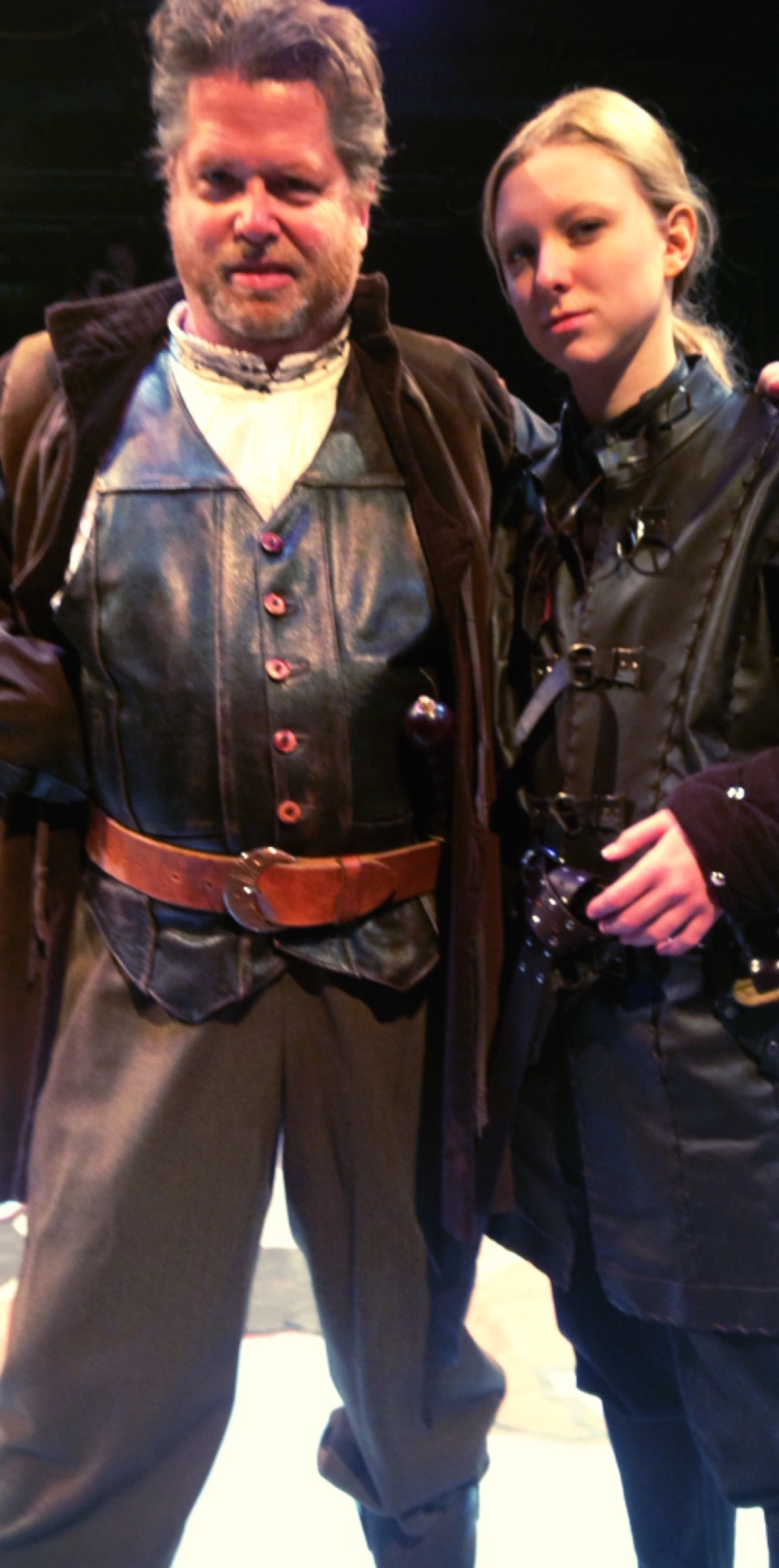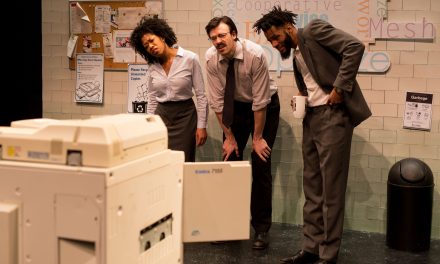Charlie Sexton & Hallie Riddick in Henry IV, Part 1
Photo-Laura Patterson
Henry IV, Part 1
Henry IV, Part 2
By William Shakespeare
Directed by Julane Havens
Review by Keith Waits
Entire contents copyright © 2015 by Keith Waits. All rights reserved.
One of Walden Theatre’s long-standing boasts is that their student productions function as solid and worthwhile theatre as assuredly as anything cast exclusively with adult actors. In an active theatre community such as that found in Louisville (and one filled with Walden alums), that claim may be a tough one to back up, but these productions of the most famous of Shakespeare’s multi-part histories make a pretty good case.
The judicious cutting makes a lean and concise narrative that alternates the political conflict between Henry IV and Hotspur with the comic scenes of a rebellious Prince Hal and his rowdy cohorts, notably the scurrilous Sir John Falstaff. The two parts, here given a repertory staging with one cast as a part of the Young American Shakespeare Festival, are at heart a coming-age tale for Hal, the Prince of Wales and heir to the throne of England.
Part 1 is well played by a fine ensemble, but it is anchored by four strong performances.
To claim that Falstaff is one of the most enduring characters created by the greatest writer in the English language is to build perhaps unrealistic expectations for the actor who chooses to take him on. Orson Welles and Sir Ralph Richardson are but two of the famous performances in the role that have helped build the legend. Charlie Sexton’s take on the role rejects the typical snowy hair and lengthy white beard for a more naturalistic scruff, and the corpulence is suggested more through costume and posture than padding, but he effectively captures the braggadocio and buffoonery of the character, as well as the pathos of the final scenes of Part 2. Seeing as how Mr. Sexton is working with a cast half his age, the choice to not indulge in the more elaborate make-up makes sense.
This Henry is filled with gender-blind casting, and Hallie Riddick plays Prince Hal with a thoughtful blend of innocence and mischief. Her scenes with Sexton in Part 1 are her strongest, as if working with the more experienced partner raises her to new heights, but the scenes in which she inhabits the heir to the throne suffer in comparison until Part 2 isolates Hal from Falstaff entirely. As the action winds down, Ms. Riddick finds the core of the boy who would be king with confidence and authority.
Brooke Morrison, who palpably registers the weight of the king’s controversial reign, gives Henry IV himself a sober and weighty reading. Ms. Morrison has been a consistently strong presence throughout her years at Walden, and the detail and nuance she brings to Henry are the work of an actor’s actor. In the scene where her advisors depart, leaving her alone with Prince Hal, the subtle shift in her physicality as the King drops pretense and is for a few moments a father is beautifully judged.
Ciaran Brown’s Hotspur makes manifest the suggestion inherent in the name: he’s so full of rage and consumed by an appetite for revenge that his early moments threaten to overwhelm the tone of Part 1. But the choice is right and helps drive the narrative momentum. If Part 2 moves a little more slowly, it may owe something to this young actor’s absence from that play.
The overall ensemble work was good, but other notable work could be found in Will DeVary’s energetic Poins, Catherine Young’s near-psychotic Earl of Douglas (the girl is the epitome of focus) and Anne Shook’s grieving Lady Percy in Part 2. And Emma Pfitzer Price benefits by playing two contrasting roles: the scheming Worcester in Part 1 and the rowdy Pistol in Part 2, making this a showcase for her fluid talent.
Costumes by Laura Patterson are a rugged blend of fabric and leather befitting the understated militarism of the themes, and music played by Abbey Ferree and Music Director Hank Paradis provide appropriate flavor without distracting from the action. The one fault is that the blocking at times does not fully embrace the in-the-round configuration of the seating, and some key scenes are staged to the detriment of audience seated on the north side.
The tone between the two Henrys shifts from light-hearted hijinks and battlefield heroism of Part 1 to the mournful passing of a generation and the embrace of sovereignty that closes Part 2. If it makes the first half of the story a much more entertaining tale to tell, so be it. We are still left with the sad and elegiac final scenes of Henry IV, Part 2. Shakespeare nullifies these sentiments to some degree by allowing a last word, here spoken by Falstaff: a funny and tender soliloquy designed to please the audience in fine, ironic fashion. Yet the words that linger in the heart and mind are those charting the calculated betrayal of Prince Hal, now King Henry V, as Falstaff transitions from clown to tragic figure when the newly crowned monarch denies him:
I know thee not, old man. Fall to thy prayers.
How ill white hairs become a fool and a jester.
I have longed dreamed of such a kind of man,
So surfeit-swelled, so old and so profane.
But being awaked I do despise my dream.
Henry IV, Part 1
Henry IV, Part 2
Part of the 2015 Young American Shakespeare Festival
Part 1
May 8, 12, 15, @ 7:30pm
May 10 & 17 @ 2:00pm
Part 2
May 10, 13, 17, @ 7:30pm
May 9 & 16 @ 2:00pm
Walden Theatre / Blue Apple Players
The Nancy Niles Sexton Stage
1125 Payne Street
Louisville, Kentucky 40206
502- 589-0084
Waldentheatre.org
[box_light]
 Keith Waits is a native of Louisville who works at Louisville Visual Art during the days, including being one of the hosts of PUBLIC on ARTxFM, but spends most of his evenings indulging his taste for theatre, music and visual arts. His work has appeared in Pure Uncut Candy, TheatreLouisville, and Louisville Mojo. He is now Managing Editor for Arts-Louisville.com.[/box_light]
Keith Waits is a native of Louisville who works at Louisville Visual Art during the days, including being one of the hosts of PUBLIC on ARTxFM, but spends most of his evenings indulging his taste for theatre, music and visual arts. His work has appeared in Pure Uncut Candy, TheatreLouisville, and Louisville Mojo. He is now Managing Editor for Arts-Louisville.com.[/box_light]





![Theatre [502] In Transition](https://arts-louisville.com/wp-content/uploads/2019/10/72854126_10157359799716839_7211972597972467712_o-440x264.jpg)